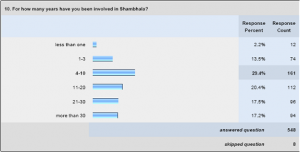Monday
Mandala ProjectsSurvey Results Are In!
The first ever Shambhala Community Survey is complete and the results are now available to the entire community on Shambhala.org. The extensive survey, launched on Shambhala Day 2008, was sent to one out of every four Shambhala members by email and by post, in four languages. 550 responses were collected, allowing for a statistically representative sample of Shambhalians. It has taken the survey team a year to compile this huge response.
The survey aimed to tackle three key questions identified by President Reoch on his tour of North American Shambhala Centres in the fall of 2006:
1) How can we create a deeper sense of community?
2) How can we nurture greater harmony in the sangha and work more effectively with conflict?
3) How can we improve communication at all levels of the mandala?
The results…
You can now view the results and analysis of the first two sections of the survey: Demographics and Community. The remaining sections – Conflict, Communication, and Practice – will be released in the coming weeks.
Here are a few sample findings from the survey which can be explored further by reading the survey results:
To view results and analysis for the first two sections of the survey (Demographics and Community), and for more information on how the survey was designed, conducted, and analyzed, click here.
The survey was created by an international team of volunteers led by Mary Whetsell. Special thanks to Judith Broadus and Vincent Dummer for their work on the analysis of the survey results. This summary was co-authored with Jil Amadio.
Stay tuned for the release of the third section of the survey: “Seeds of (Dis)Harmony” – to be announced soon…








Mar 3, 2009
Reply
Thank-you, Suzanne!
We were conscious in conducting this survey that even many members of Shambhala so not receive sangha-related emails, or access Shambhala.org on a regular basis. In fact, not all members even have Internet access. The survey was therefore administered to a random sample of one in four Shambhala members listed on the database (if you are a member of your local centre or of Shambhala International than you are listed on the database). For those with active email addresses, it was administered by email. For others it was administered by post.
The Oath of Shambhala is not a requirement for membership, though there is a membership oath that can be taken at a Shambhala Centre (not all members would have taken the membership oath, as this process has evolved over the years).
Of course, I have not addressed your point that some people may have a strong heart connection to Shambhala and to the community, but do not (at this point in their lives, in any case) pay dues or participate in their local centres or in the Shambhala organization. I see this group as including many children and young adults who are part of the community but have not become ‘members’, per se. As a researcher, I’m at a bit of a loss as to how we could get a handle on this ‘community’ for the purposes of this type of research, so I have to aknowledge the gap!
Best,
Victoria
Mar 3, 2009
Reply
Hi Victoria,
I would define the Shambhala community (lowercase :-) as a bunch of people who might or might not belong to any organization, but took the Oath of Shambhala with either Sakyong, perhaps, or those who took any vow with either teacher. I think of the world Shambhalians as independent agents in a network that spans all the organizations but is free from all of them at the same time.
There has been a lot of discussion around what “membership” in Shambhala International entails or means, but the most clear boundary I see is that those who are not members would not receive mail from or have access to any posts on the sangha e-mail lists/discussion groups or other internal “members-only” pages on shambhala.org. Therefore I figured that a very substantial section of the Shambhala community/network was missing from the questionnaire, since they could not be contacted through those avenues.
Mar 3, 2009
Reply
Hi Suzanne,
I would be interested to hear how you (and others) would define the Shambhala Community. This definition gets right to the heart of some of the issues, I’m sure. It’s often a good place to start a conversation…
For the purpose of the survey we used Shambhala “membership” – in large part because there is now a shared definition of membership across the entire mandala, and we have a shared database so that we know who the members are. The definition of membership is certainly inclusive of people who are students of Chogyan Trungpa Rinpoche but do not consider themselves to be students of Sakyong Mipham Rinpoche (membership definition and oath are available on Shambhala.org). If you look at the survey results, you will see that many people in this category did respond to the survey, as did people who are members of Shambhala but do not consider either Sakyong to be their teacher. Our survey respondents also varied widely in the degree to which they participate actively in their centres – from daily to not at all.
I look forward to releasing the remainder of the survey results. In the section entitled “Seeds of (Dis)Harmony”, survey respondents were asked questions regarding the type of conflict you may be alluding to in your critique of the use of the word “community”, and you may find the results interesting.
All the best,
Victoria
Mar 2, 2009
Reply
I do not think this survey is inclusive by any means — or at least it is misnamed. It is not a “Shambhala COMMUNITY Survey.” The Shambhala community is MUCH larger than Shambhala International. If all students who hold samaya with Chogyam Trungpa were included, for example, and/or who took the Oath of Shambhala with the Druk Sakyong, imagine how the demographics and “results” would change! It would be more appropriate to call it “Shambhala INTERNATIONAL Survey” or “Shambhala MEMBERSHIP Survey.”
Feb 26, 2009
Reply
Hi Nyima,
The author is Victoria Hagen – author profiles are located to the right of the relevant headline.
Best,
Your Editors
Feb 25, 2009
Reply
Who wrote this article? Author isn’t mentioned